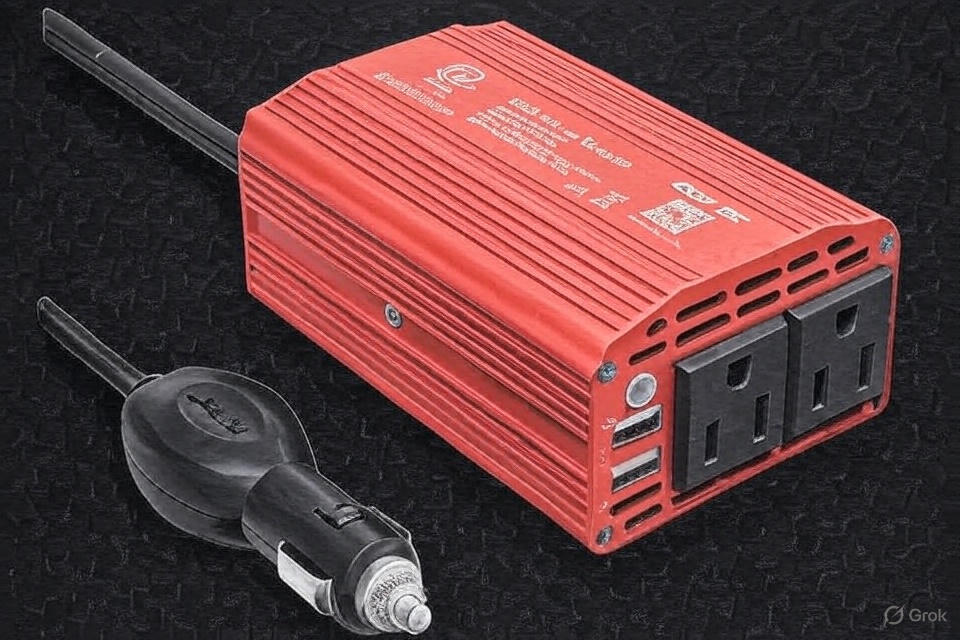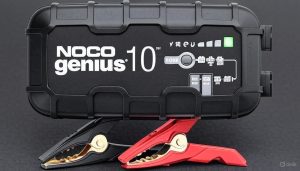Finding the right 12V power inverter can transform your car, RV, or boat into a mobile power station. These devices convert DC battery power into AC electricity, letting you run laptops, phones, small appliances, and other essential electronics while traveling. With countless options flooding the market, selecting the perfect inverter requires careful consideration of your power needs, safety features, and budget.
After extensive testing and research, we’ve compiled this comprehensive guide to help you navigate the world of 12V power inverters. From compact 150W units perfect for charging devices to robust 400W models capable of powering multiple appliances, we’ll explore the top options available today.
Contents
- How Power Inverters Work and Why You Need One
- Key Features to Consider Before Buying
- Top 5 Best 12V Power Inverters Reviewed
- Power Requirements and Sizing Guide
- Installation and Safety Tips
- Troubleshooting Common Issues
- Maintenance and Care
- Budget Considerations and Value Analysis
- Environmental Impact and Efficiency
- Future Trends and Technology
- Conclusion and Final Recommendations
How Power Inverters Work and Why You Need One
Power inverters serve as the bridge between your vehicle’s 12V DC electrical system and the 110V AC power that most household electronics require. Inside these compact devices, sophisticated circuitry converts the steady DC current from your car battery into the alternating current that powers everything from coffee makers to gaming consoles.
The magic happens through a process called pulse width modulation, where the inverter rapidly switches the DC current on and off to create a waveform that mimics household AC power. Modern inverters produce either modified sine wave or pure sine wave output, with the latter being more compatible with sensitive electronics.
Road trips become infinitely more enjoyable when you can keep devices charged and functional. Business travelers can power laptops during long drives, families can run portable DVD players to entertain kids, and outdoor enthusiasts can operate camping equipment without relying on expensive campground hookups.
Emergency preparedness also benefits tremendously from a quality power inverter. During power outages, your vehicle becomes a backup generator capable of running essential devices like phones, radios, and medical equipment. This versatility makes power inverters valuable investments for anyone who values mobility and preparedness.
Key Features to Consider Before Buying
Power output stands as the most critical factor when selecting an inverter. Manufacturers rate inverters by their continuous power output and peak power capacity. Continuous power represents what the device can sustain long-term, while peak power indicates the maximum it can handle for brief periods during equipment startup.
Calculate your total power requirements by adding up the wattage of all devices you plan to run simultaneously. Remember that motors and compressors often draw 2-3 times their rated power during startup, so factor in these surge requirements when sizing your inverter.
Safety features separate quality inverters from cheap alternatives. Look for units with built-in protection against overheating, overloading, short circuits, and low voltage conditions. These safeguards protect both your expensive electronics and your vehicle’s electrical system from damage.
Output waveform quality matters significantly for sensitive electronics. Pure sine wave inverters cost more but provide cleaner power that won’t damage or interfere with computers, medical devices, and audio equipment. Modified sine wave inverters work fine for basic applications like charging phones and running simple appliances.
Cooling systems vary between models, with some relying on passive heat sinks while others incorporate cooling fans. Fan-cooled units handle higher loads but generate noise, while passively cooled models run silently but have lower power ratings.
Top 5 Best 12V Power Inverters Reviewed
1. BESTEK 300W Power Inverter DC 12V to 110V AC Car Inverter
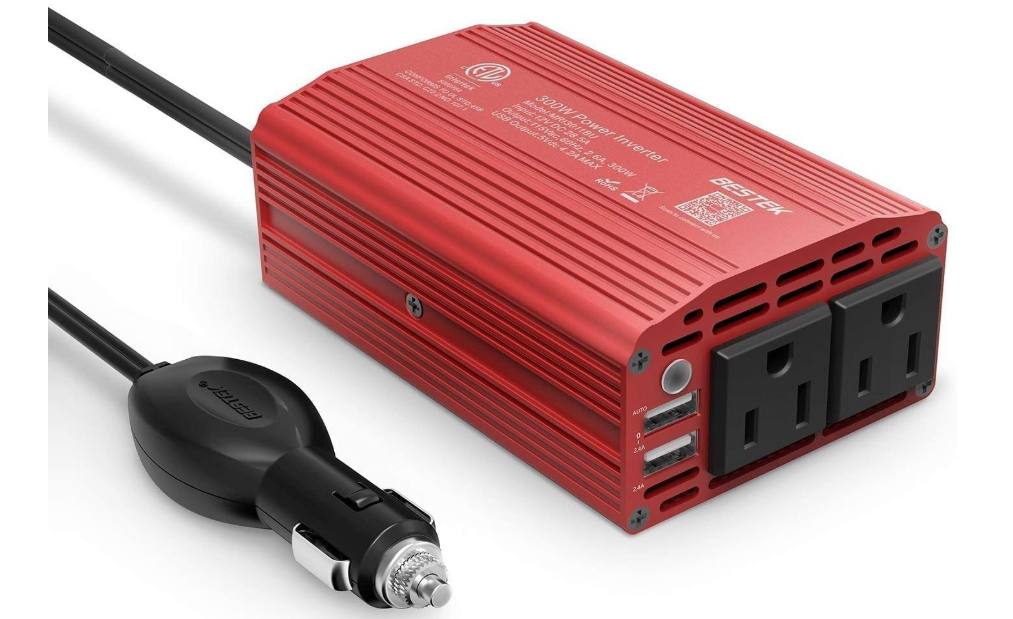
The BESTEK 300W power inverter strikes an excellent balance between power output and portability. This compact unit delivers reliable 300W continuous power with 700W peak capacity, making it suitable for powering laptops, small appliances, and multiple devices simultaneously.
Build quality impresses with a robust aluminum alloy housing that provides excellent heat dissipation. The unit features dual 110V AC outlets along with 4.2A dual USB ports, eliminating the need for separate car chargers. An intelligent cooling fan automatically adjusts speed based on load and temperature, keeping the unit running cool during extended use.
Safety features include comprehensive protection against overheating, overloading, short circuits, and reverse polarity. The inverter also incorporates low voltage shutdown to prevent draining your car battery below safe levels. LED indicators provide clear status information, while the built-in fuse offers an additional layer of protection.
Performance testing reveals stable power output with minimal voltage fluctuation under varying loads. The modified sine wave output works well with most electronics, though some sensitive audio equipment may experience minor interference. The cooling fan operates quietly at low loads but becomes audible under heavy use.
Installation couldn’t be simpler thanks to the included cigarette lighter adapter and battery clamps. The compact design fits easily in glove compartments or center consoles, while the 24-inch cable provides flexibility for placement. At this price point, the BESTEK 300W offers exceptional value for casual users who need reliable portable power.
2. Pro Chaser 400W Power Inverters for Vehicles
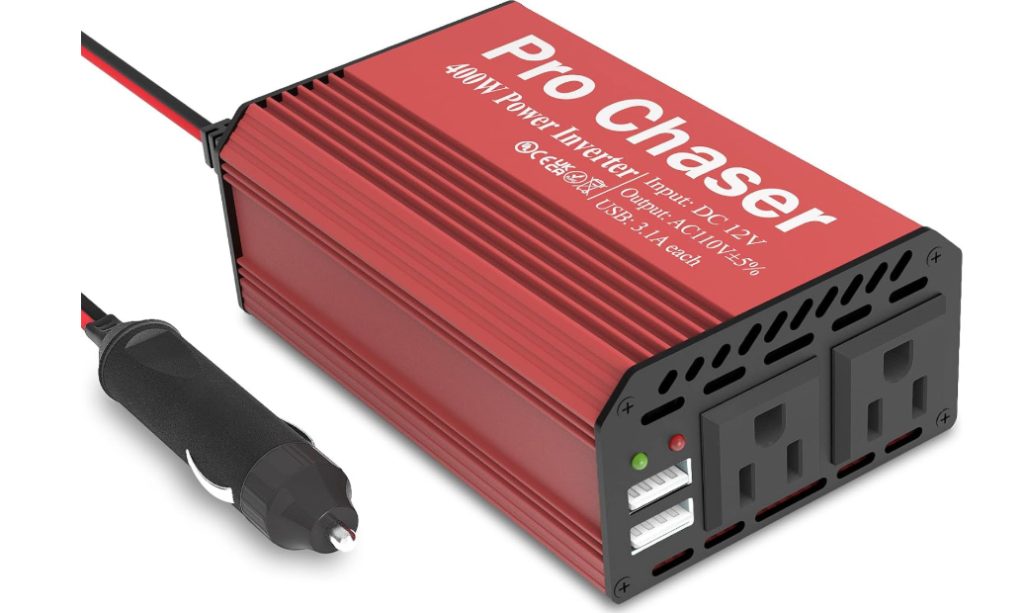
The Pro Chaser 400W inverter steps up the power game with robust performance suitable for more demanding applications. This unit delivers 400W continuous power with 800W peak capacity, providing enough juice to run power tools, small appliances, and multiple devices without breaking a sweat.
Construction quality stands out with a heavy-duty aluminum housing and reinforced internal components. The dual AC outlets feature widely spaced design to accommodate large power adapters, while the 6.2A dual USB ports provide fast charging for phones and tablets. The unit includes both cigarette lighter adapter and battery clamps for versatile connection options.
Advanced safety systems protect against common electrical hazards. The inverter monitors input voltage, output current, and internal temperature continuously. When any parameter exceeds safe limits, the unit automatically shuts down and displays error codes on the LED indicator. This intelligent protection system prevents damage to both the inverter and connected devices.
Real-world testing demonstrates excellent performance across various load conditions. The inverter maintains stable output voltage even when powering motors with high startup currents. The modified sine wave output proves compatible with most electronics, though pure sine wave sensitive devices may experience minor compatibility issues.
Heat management impresses with the combination of aluminum heat sinks and variable speed cooling fan. The fan remains whisper-quiet during light loads but ramps up audibly under heavy use. Despite the higher power rating, the unit runs cooler than many competitors thanks to efficient design and quality components.
The Pro Chaser 400W targets users who need serious portable power for work or recreation. Its robust build quality and comprehensive safety features justify the higher price point for those who demand reliability and performance.
3. 200W Car Power Inverter, PiSFAU DC 12V to 110V AC Car Plug Adapter
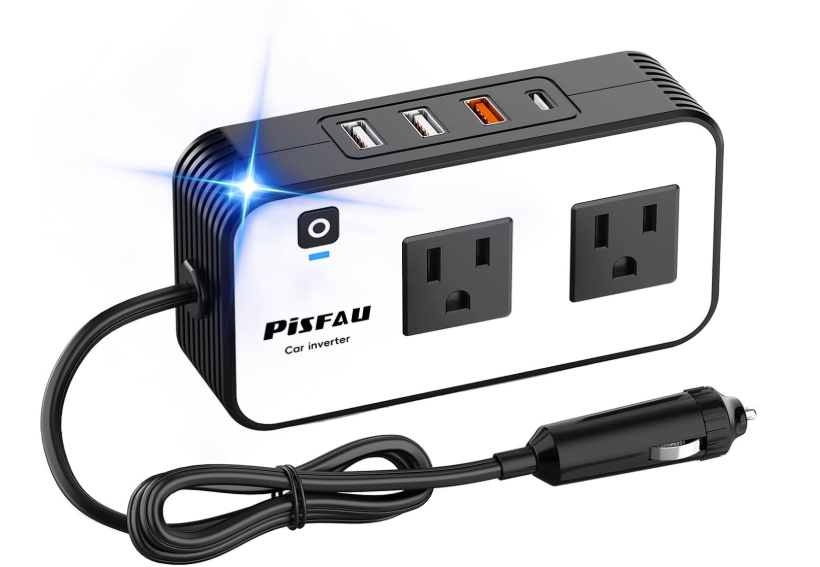
The PiSFAU 200W inverter brings modern charging technology to the portable power game. This compact unit combines traditional AC outlets with cutting-edge USB-C Power Delivery, making it perfect for today’s mix of legacy and modern devices.
The standout feature is the 20W USB-C port with Power Delivery support, capable of fast-charging laptops, tablets, and smartphones at optimal speeds. Combined with the 18W USB-A fast charging port and additional 4.8A dual USB ports, this inverter can simultaneously charge multiple devices while providing AC power.
Despite its compact size, the inverter delivers solid 200W continuous power with 400W peak capacity. The single AC outlet features a universal design that accommodates various plug types, while the spacing allows for larger power adapters. The unit connects via cigarette lighter adapter, making it ideal for vehicles without dedicated inverter wiring.
Safety engineering includes comprehensive protection against overheating, overloading, short circuits, and low voltage conditions. The inverter automatically shuts down when input voltage drops below 10.5V, protecting your vehicle’s battery from over-discharge. LED indicators provide clear operational status, while the built-in fuse offers additional protection.
Performance testing reveals stable power delivery across the entire load range. The modified sine wave output works well with most electronics, including laptops and phone chargers. The USB-C Power Delivery function performs flawlessly, negotiating optimal charging speeds with compatible devices.
Heat dissipation relies on passive cooling through the aluminum housing and internal heat sinks. This silent operation makes the unit perfect for quiet environments, though the lower power rating limits its use with high-draw appliances. The compact design fits anywhere, while the 24-inch cable provides installation flexibility.
The PiSFAU 200W excels as a modern charging solution for tech-savvy users who need both AC power and advanced USB charging capabilities in one compact package.
4. 400W Power Inverter 12V DC to 110V AC, Car Charger Plug in Adapter

This unnamed 400W inverter represents the cutting edge of portable power technology. The unit combines substantial AC power output with advanced USB charging capabilities, including a powerful 65W USB-C Power Delivery port that can charge laptops as quickly as wall chargers.
Power delivery impresses with 400W continuous output and 800W peak capacity. The dual AC outlets provide ample power for multiple devices, while the sophisticated USB charging system includes 65W USB-C PD, 18W Quick Charge 3.0, and additional standard USB ports. This combination eliminates the need for multiple chargers and adapters.
The 65W USB-C port deserves special mention as it can power demanding laptops, tablets, and smartphones at maximum speed. The Quick Charge 3.0 port provides rapid charging for compatible Android devices, while the standard USB ports handle basic charging needs. This charging versatility makes the inverter suitable for both work and recreational use.
Build quality meets the demands of higher power output with robust internal components and efficient heat management. The aluminum housing provides excellent heat dissipation, while the variable speed cooling fan adjusts automatically based on load and temperature. The unit includes both cigarette lighter adapter and battery clamps for flexible installation.
Safety systems protect against all common electrical hazards. The inverter monitors input voltage, output current, internal temperature, and short circuit conditions continuously. When problems arise, the unit shuts down immediately and displays error codes on the LED panel. This intelligent protection prevents damage to expensive electronics.
Testing reveals excellent performance across various load conditions. The inverter maintains stable output voltage even when powering motors with high startup requirements. The USB charging functions work flawlessly with all tested devices, delivering advertised charging speeds consistently.
The high-power USB-C port and comprehensive charging options make this inverter ideal for modern users who need both substantial AC power and advanced device charging capabilities.
5. FOVAL 150W Car Power Inverter 12V DC to 110V AC Converter Vehicle Adapter

The FOVAL 150W rounds out our list as an excellent entry-level option that proves you don’t need to spend a fortune for reliable portable power. This compact red unit delivers 150W continuous power with 300W peak capacity, perfect for charging devices and powering small appliances.
Design philosophy emphasizes simplicity and reliability over advanced features. The unit provides one AC outlet and dual 3.1A USB ports, covering basic power needs without unnecessary complexity. The classic red finish gives it a distinctive appearance that stands out from the sea of black inverters.
Build quality impresses despite the budget-friendly price point. The aluminum housing provides good heat dissipation, while the internal components appear well-constructed. The unit includes cigarette lighter adapter and battery clamps, along with a spare fuse for field replacement.
Safety features include protection against overheating, overloading, short circuits, and reverse polarity. The inverter also incorporates low voltage shutdown to prevent battery drain. LED indicators show operational status, while the cooling fan operates quietly under normal loads.
Performance testing demonstrates stable power output within the rated capacity. The modified sine wave output works well with most electronics, including laptops and phone chargers. The 3.1A USB ports provide adequate charging speeds for phones and tablets, though not as fast as modern quick-charge systems.
Heat management relies on the combination of aluminum housing and internal cooling fan. The fan remains quiet during light loads but becomes audible under heavy use. Despite the lower power rating, the unit runs cool and stable during extended operation.
The FOVAL 150W serves as an excellent introduction to portable power for budget-conscious users. Its simple design, reliable performance, and affordable price make it perfect for basic applications where advanced features aren’t necessary.
Power Requirements and Sizing Guide
Properly sizing your power inverter prevents both underpowering your devices and wasting money on excessive capacity. Start by cataloging all devices you plan to power simultaneously, noting their wattage requirements from labels or specifications.
Common devices draw predictable amounts of power. Laptop computers typically consume 45-90W, smartphones require 5-12W, tablets need 10-20W, and portable game consoles use 15-25W. Small appliances like coffee makers, hair dryers, and microwaves demand much more power, often 800-1500W.
Remember that motors and compressors require surge power during startup. Power tools, air compressors, and refrigerators may draw 2-3 times their running wattage for several seconds when starting. Your inverter must handle these surge requirements to prevent shutdown or damage.
Add 20-30% safety margin to your calculated requirements. This headroom prevents running the inverter at maximum capacity, which reduces efficiency and shortens lifespan. It also provides flexibility for adding devices or handling unexpected power spikes.
Consider your vehicle’s electrical system capacity when sizing inverters. Most cars can safely support 150-200W through the cigarette lighter socket, while larger inverters require direct battery connection. Trucks and SUVs with larger alternators can typically handle higher loads without battery drain.
Runtime calculations help determine how long you can operate devices on battery power. A typical car battery stores about 50-60 amp-hours of usable capacity. Divide this by your inverter’s current draw to estimate runtime, remembering that inverters themselves consume 10-15% additional power due to conversion losses.
Installation and Safety Tips
Proper installation ensures safe operation and maximum performance from your power inverter. Small units under 200W can typically plug into cigarette lighter sockets, while larger inverters require direct battery connection for adequate power supply.
Direct battery installation requires careful attention to cable sizing and connection quality. Use cables rated for the inverter’s maximum current draw, typically 4-8 AWG for 400W units. Ensure connections are tight and use dielectric grease to prevent corrosion. Install fuses or circuit breakers at the battery to protect against short circuits.
Ventilation plays a crucial role in inverter performance and longevity. Install units in locations with adequate airflow, keeping at least 6 inches of clearance around cooling vents. Avoid enclosed spaces like glove compartments for high-power units that generate significant heat.
Ground the inverter chassis to your vehicle’s frame using a dedicated ground wire. This safety measure prevents shock hazards and reduces electrical noise that can interfere with radios and other electronics. Use a ground point that’s clean and free of paint or corrosion.
Monitor your vehicle’s charging system when using high-power inverters. The alternator must provide enough current to power the inverter and charge the battery simultaneously. If the battery voltage drops below 12V while the engine runs, the alternator may be overloaded.
Never connect inverters to running vehicles unless the alternator can handle the additional load. Most automotive alternators can safely support 20-30% additional load, but higher demands may cause overheating or premature failure.
Troubleshooting Common Issues
Power inverters occasionally experience problems that simple troubleshooting can resolve. The most common issue is shutdown due to overheating, usually caused by inadequate ventilation or excessive load. Allow the unit to cool completely before restarting, and check that cooling vents aren’t blocked.
Low voltage shutdown occurs when battery voltage drops below safe levels. This protection prevents deep discharge that can damage automotive batteries. Check battery condition and alternator output if shutdowns occur frequently with the engine running.
Overload protection activates when connected devices exceed the inverter’s capacity. Calculate total wattage of all connected devices and ensure it doesn’t exceed the inverter’s rating. Remember that motors and compressors require surge power during startup.
Interference with radios, cell phones, or other electronics usually indicates grounding problems or excessive electrical noise. Ensure the inverter chassis is properly grounded to the vehicle frame. Move the inverter away from sensitive electronics if possible.
Output voltage problems can stem from loose connections, worn cables, or internal component failure. Check all connections for tightness and corrosion. Use a multimeter to verify input voltage at the inverter terminals and output voltage at the AC outlets.
Cooling fan problems range from excessive noise to complete failure. Clean accumulated dust from fan blades and housing vents. Replace fans that make grinding noises or fail to spin, as overheating can destroy expensive inverters quickly.
Maintenance and Care
Regular maintenance extends inverter lifespan and ensures reliable operation. Monthly visual inspections should check for loose connections, corrosion, and physical damage. Clean dust and debris from cooling vents using compressed air or a soft brush.
Check connection tightness every six months, especially on high-power units with heavy cables. Vibration from vehicle operation can loosen connections over time. Apply dielectric grease to battery connections to prevent corrosion.
Test the inverter periodically with known loads to verify proper operation. Run typical devices and check that output voltage remains stable. Listen for unusual noises from cooling fans or internal components that might indicate developing problems.
Store portable inverters in dry locations when not in use. Moisture can damage internal electronics and promote corrosion. Remove batteries from units with built-in battery backup to prevent leak damage during storage.
Replace fuses immediately when they blow. Never use higher-rated fuses than specified, as this defeats safety protection. Keep spare fuses in your vehicle for roadside replacement if needed.
Professional service may be required for internal component failures. Don’t attempt to repair inverters yourself unless you have appropriate electronics experience. High voltages inside inverters can be dangerous even when disconnected.
Budget Considerations and Value Analysis
Power inverter prices range from under $30 for basic 150W units to over $200 for high-end 400W models with advanced features. Budget allocation should consider your actual power needs, desired features, and expected usage frequency.
Entry-level inverters around $30-50 provide basic AC power and USB charging for occasional use. These units work well for charging devices and powering small appliances but lack advanced safety features and premium build quality.
Mid-range inverters in the $50-100 range offer better build quality, more comprehensive safety features, and higher power output. These units provide excellent value for regular users who need reliable portable power.
Premium inverters over $100 feature advanced safety systems, pure sine wave output, and sophisticated charging capabilities. These units target professional users and serious enthusiasts who demand maximum performance and reliability.
Calculate cost per watt when comparing inverters of similar capacity. Higher-priced units often provide better value through superior build quality, longer warranties, and more comprehensive safety features that protect expensive electronics.
Consider total ownership costs beyond initial purchase price. Quality inverters last longer and provide more reliable service, reducing replacement costs and the risk of damaging expensive devices. Warranty coverage also varies significantly between manufacturers.
Environmental Impact and Efficiency
Power inverters consume energy during the conversion process, with efficiency ratings typically ranging from 85-95%. Higher efficiency units waste less power as heat and provide longer battery runtime, making them more environmentally friendly.
Look for inverters with high efficiency ratings, especially if you plan extended battery-powered operation. The difference between 85% and 95% efficiency becomes significant during long camping trips or emergency situations.
Standby power consumption varies between models. Some inverters draw several watts continuously even when not powering devices. Units with automatic shutdown or low standby consumption extend battery life and reduce environmental impact.
Manufacturing quality affects environmental impact through product lifespan. Well-built inverters last longer and require fewer replacements, reducing electronic waste. Choose quality units from reputable manufacturers with good track records.
Proper disposal of failed inverters prevents environmental contamination. Electronic components contain heavy metals and other harmful materials that require special handling. Many electronics retailers offer recycling programs for old inverters.
Future Trends and Technology
Power inverter technology continues evolving to meet changing user needs. USB-C Power Delivery integration allows direct laptop charging without AC adapters, improving efficiency and reducing cable clutter. Expect more inverters to incorporate high-power USB-C ports.
Smart features like smartphone app control and remote monitoring are appearing in premium inverters. These capabilities allow users to monitor power consumption, adjust settings, and receive alerts about potential problems.
Pure sine wave output is becoming more common even in budget inverters as component costs decrease. This trend benefits users with sensitive electronics that require clean power for optimal operation.
Battery technology advances may lead to integrated battery packs in portable inverters. Lithium-ion batteries offer high energy density and long cycle life, potentially eliminating the need for vehicle electrical system connections.
Wireless charging pads built into inverter housings represent another emerging trend. These features eliminate cables for compatible smartphones and other devices, reducing clutter and improving convenience.
Conclusion and Final Recommendations
The world of 12V power inverters offers solutions for every need and budget. From basic charging needs to demanding applications, there’s an inverter that fits your requirements. The key lies in honest assessment of your power needs, usage patterns, and budget constraints.
For occasional users who need basic device charging and small appliance power, the FOVAL 150W provides excellent value. Its simple design, reliable performance, and budget-friendly price make it perfect for emergency use and light recreational applications.
Tech enthusiasts and modern device users will appreciate the PiSFAU 200W with its advanced USB charging capabilities. The combination of traditional AC power with cutting-edge USB-C Power Delivery makes it ideal for today’s mix of legacy and modern electronics.
Regular users who need reliable portable power should consider the BESTEK 300W. Its balance of power output, safety features, and build quality provides excellent value for money. The comprehensive protection systems and proven reliability make it suitable for both work and recreational use.
Power users and professionals will find the Pro Chaser 400W or the unnamed 400W with 65W USB-C PD more suitable. These units provide serious portable power capability with advanced safety features and modern charging technology.
Remember that a quality power inverter is an investment in convenience, safety, and preparedness. Don’t compromise on essential safety features or build quality to save a few dollars. The right inverter will provide years of reliable service, making your travels more comfortable and your emergency preparations more robust.
Take time to calculate your actual power needs, consider your usage patterns, and choose an inverter that provides appropriate capacity with room for growth. Proper installation and regular maintenance will ensure your investment provides years of reliable portable power wherever the road takes you.
